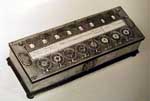Mechanical Calculators
History of the Mechanical Calculating Device
 Mechanical Calculators Mechanical Calculators
One of the earliest calculating devices on record is the abacus. The abacus has been widely known and used for over 2,000 years. Basically it is a basic wooden rack that holds parallel rods in which beads are strung. According to certain rules the beads are manipulated back and forth and several various arithmetic operations can be performed.
In the early 1600’s a man named Charles Napier who was the inventor of logarithms developed a series of rods that could be used to assist with numeric multiplication. Later this invention was called Napier’s Bones.
Blaise Pascal is usually credited with the building of the first digital calculating machine in the year 1642. This calculating machine could perform the addition of numbers entered on dials. An interesting fact is that this invention was developed to help his father who was in the tax business.
In 1671 a man named Gottfried Wilhelm von Leibniz invented a calculator. This invention was not built however until 23 years later in 1694. This calculating machine could add and actually multiply by successive adding and shifting. Pretty cool!
Finally in the year 1820 inventor Charles Xavier Thomas developed the first commercially successful mechanical calculating device that could add, subtract, multiply, and even devide. The rest was history and after Charles’ invention various other inventors followed with improving the mechanical calculating device, or simply the calculator as we know it.
Return to:
Return
from Mechanical Calculators to Home Page
Contact us | View site map
|